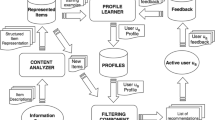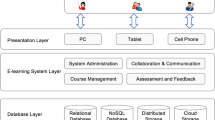Abstract
Many researches about e-learning system have been applied item difficulty to increase learning effectiveness. And development environment was changed the internet based learning media contents into the more various technology such as component, web 2.0, service oriented development and so on. Especially, service-oriented development is one of new trend in web based system and has become mainstream in software development. In the development, web components aims at providing support to service-oriented technique by enabling automatic discovery, composition, invocation and interoperation of the services. In this paper, we aimed the implementation of English e-learning system including the item guessing parameter and considering the relative correction of item difficulty. In the system, a learner was given to choose the learning step by the relative difficulty. In order to process and combine, all the learning contents are based on Sharable Content Object Reference Model (SCORM) with Learning Management System (LMS). Also, each learning contents are belong to Sharable Content Objects (SCOs).












Similar content being viewed by others
References
Advanced Distributed Learning Sharable Content Object Reference Model Version 1.2, ADLNet, Advaced Distributed Learning Initiative, 2001
Barr A (2006) Revisiting the -ilities: adjusting the distributed learning marketplace. Again Learn Technol Newsl IEEE Comput Soc 8:3–4
Battle S (2002) Web components: services that wear state on their sleeve. OMG Web-services workshop, Hewlett-Packard
Benyon D, Stone D, Woodroffe M (1997) Experience with developing multimedia courseware for the World Wide Web: the need for better tools and clear pedagogy. Int J Hum Comput Stud 47:197–218
Birnbaum A (1968) Some latent trait models and their use in inferring an examinee’s ability, Addison-Wesley
Chen C-M (2008) Intelligent web-based learning system with personalized learning path guidance. Comput Educ 51:787–814
Chen L-H (2010) Web-based learning programs: use by learners with various cognitive styles. Comput Educ 54:1028–1035
David FD, Hu X, Eric C, Mathews, Susarla S (2006) Intelligent Delivery of Sharable Content Objects—An Integrated Solution to Enhance Learning, Learning Technology Newsletter, IEEE Computer Society 8
Fei YK, Wang ZJ (2004) A Concept Model of Web Components, Proceedings of the 2004 IEEE International Conference on Services Computing
Frank Baker B (2001) The basics of Item response theory, ERIC Clearinghouse on Assessment and Evaluation
Gord Mackenzie, SCORM 2004 Primer A (Mostly) Painless Introduction to SCORM Version 1.0, McGill 2004
Iribarne L (2004) Web components: a comparison between web services and software components. Colombian J Comput 5(1)
Jeong HY (2005) Learner’s tailoring E-learning system on the item revision difficulty using petrinet VSMM 2006. LNCS 4270:318–327
Liu YC, Chien HW, Huang SH (2004) An Novel Data Management System of Teaching Material Conforming with SCORM, Proceedings of the IEEE International Conference on Advanced Learning Technologies, IEEE computer society
Ozkan S, Koseler R (2009) Multi-dimensional students’ evaluation of e-learning systems in the higher education context: an empirical investigation. Comput Educ 53:1285–1296
Perrin KM, Mayhew D (2000) The reality of designing and implementing an internet-based course. Online Journal of Distance Learning Administration 13 (4)
STAR Early Literacy and Item Difficulty, STAR Early Literacy Application Note pp. 103, March 2002
Verbert K, Jovanovic J, Gaševic D, Duval E, Meire M (2005) Towards a global component architecture for learning objects: a comparative analysis of learning object content models, proceedings of world conference on educational multimedia, hypermedia and telecommunications
Windsor JA, Diener S, Zoha F (2008) Learning style and laparoscopic experience in psychomotor skill performance using a virtual reality surgical simulator. Am J Surg 195:837–842
Zeramdin K, Rekik Y, Gillet D (2004) Enhanced Web Components and Connectors Description for Authoring e-Learning Environments, 5th Int. Conf. on Information Technology Based Higher Education and Training
Author information
Authors and Affiliations
Corresponding author
Rights and permissions
About this article
Cite this article
Jeong, HY., Hong, BH., Shrestha, B. et al. English course E-learning system based on relative item difficulty using web component composition. Multimed Tools Appl 61, 225–241 (2012). https://doi.org/10.1007/s11042-010-0708-7
Published:
Issue Date:
DOI: https://doi.org/10.1007/s11042-010-0708-7




